Giovanni Caselli
Giovanni Caselli (8 June 1815 – 25 April 1891) was an Italian priest, inventor, and physicist. He studied electricity and magnetism as a child which led to his invention of the pantelegraph (a.k.a. Universal Telegraph or all-purpose telegraph), the forerunner of the present day fax machine. The world's first practical operating facsimile machine ("fax") system put into use was by Caselli. He had worldwide patents on his system. His technology idea has been further developed and is now today's television.
Giovanni Caselli | |
|---|---|
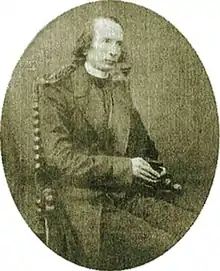 Giovanni Caselli | |
| Born | 25 April 1815 |
| Died | 8 June 1891 (aged 76) |
| Nationality | Italian |
| Education | University of Florence |
| Occupation | inventor |
| Known for | pantelegraph |
Caselli was a student and professor at the University of Florence in Italy. He started a technical journal that explained physics in layman's terms. He was awarded by Napoleon III of France the Legion of Honor for his pantelegraph technology. Parisian scientists and engineers started the Pantelegraph Society to exchange his ideas about the pantelegraph and the associated synchronizing apparatus to get the sending and receiving mechanisms to work together properly to produce the desired results.
Early life
Caselli was born in the town of Siena, Italy, on 25 April 1815. As a child he was tutored in Florence by Leopoldo Nobili as his instructor.[1] These studies involved electrochemistry, electromagnetism, electricity and magnetism.[2] He became a priest in 1836.[3] Caselli became a student at the University of Florence and studied literature, history, science, and religion.[4] He lived in Parma from 1841 to 1848 and was a teacher for the sons of the Marquis of the basilica of San Vitale. He participated in the insurrection of 1848 for the takeover of Duchy of Parma to be part of Piedmont and was expelled from the area for his actions of the political violence.[1] He returned to Florence where he became a professor in physics at the University of Florence in 1849.[3] In 1851, he founded the technical journal La Ricreazione that explained physics, written in layman's terms, to the public.[5] He studied electricity and magnetism creating between 1855 and 1861 the pantelegraph, which was the precursor of the FAX machine.
Pantelegraph
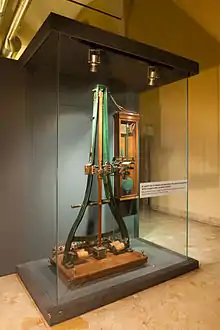
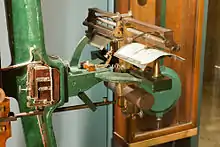
Pantèlègraph is a portmanteau from pantograph, an instrument that copies handwritten words and sketches, plus "telegraph", an electrical system that sends messages through a normal wire over long distances that could be mechanically synced. Caselli devoted much of his research into the technology of telegraphic transmission of sketches as well as handwritten words when he was teaching at the University of Florence.[3] Inventor Alexander Bain was working on this technology as was physicist Frederick Bakewell. The major problem of the time was to get perfect synchronization between the transmitting and receiving parts so they would work together correctly.[3] Caselli developed an electrochemical technology with a "synchronizing apparatus" (regulating clock) to make the sending and receiving mechanisms work together that was far superior to any technology Bain or Bakewell had.[3][2]
The technique is straight forward by using an image made using non-conductive ink on a piece of tin foil. A stylus in the electrical path of the tin foil is passed over the foil where it delicately touches it. The stylus passes evenly with scans slightly apart. Then what happens is that electricity conducts where there is no ink contacting the stylus and does not where there is ink in between. This causes spurts of electricity matching the image as it is being scanned. The signals are then sent along a long distance telegraph line. The receiving apparatus at the other end has an electrical stylus and draws blue ink on white paper reproducing the image line-by-line scanned, this being a fac simile (Latin, "make similar") of the original image scanned.[4][6]
Caselli made a prototype of his system by 1856 and presented it to the Duke of Tuscany (Leopold II), in a demonstration that used telegraph lines.[1] The Duke was so impressed with Caselli's device that for awhile he financed his experiments.[3] When the Duke's enthusiasm waned Caselli moved to Paris to introduce his invention to Napoleon III. Napoleon immediately became an enthusiastic admirer of the technology.[7] Caselli perfected his pantelegraph (also known as the autotelegraph) between 1857 and 1861 in Paris under the leadership of French inventor and engineer Paul-Gustave Froment.[8] The world's first practical operating facsimile machine ("fax") system put into use was by Caselli with a scanning technology he devised.[4] Alexander Graham Bell received his telephone patent in 1876 - that then introduced telephone lines for the first time.[9]
In 1858 Caselli's improved version was demonstrated by French physicist Alexandre-Edmond Becquerel at the Academie of Science in Paris.[10] Napoleon saw in 1860 a demonstration given of Caselli's pantelegraph and then put in an order for the operation of it within the French telegraph network that started about a year later in the country.[10] Caselli had access to not only the French telegraph lines for his pantelegraph facsimile machine technology, but finances were provided by Napoleon. A test was done successfully then between Paris and Amiens with the signature of composer Gioacchino Rossini as the image sent and it was received 87 miles (140 km) away recognizable.[10]
Caselli did testing in 1863 between Paris and Marseille, a distance of 800 km, which turned out to be successful.[10] French law was enacted then in 1864 for it to be officially accepted.[10] The next year in 1865 the operations started with the Paris to Lyon line and extended to Marseille in 1867.[10][11] Caselli had invented with the pendulum and writing stylus the first commercial fax system and the birth of the fax cover sheet.[12] The mid-nineteenth century pantelegraph took about two minutes to transmit a sheet of paper 1.1 inches (28 mm) by 4.5 inches (110 mm) with 25 handwritten words on it.[13] The early twentieth century modern FAX machine takes about one minute to transmit a sheet of paper 11 inches (280 mm) by 8.5 inches (220 mm) with 250 handwritten words on it.[14]
 Caselli's pantelegraph patented in 1861
Caselli's pantelegraph patented in 1861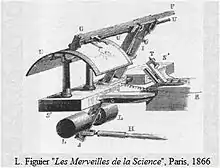 Pantelegraph "reading" tinfoil mechanism
Pantelegraph "reading" tinfoil mechanism Pantelegraph image, Paris to Lyons on 10 Feb 1862
Pantelegraph image, Paris to Lyons on 10 Feb 1862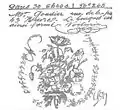 Caselli pantelegraph images were blue ink
Caselli pantelegraph images were blue ink
Later life and legacy
Caselli applied in 1861 for a patent for his pantélégraphe in Europe and ultimately received European Patent #2532 for the device. He applied for a patent in 1863 in the United States and it received patent number 37,563. Caselli successfully demonstrated his pantelegraph in 1861 at the Florence Exhibition to an audience which had the King of Italy, King Victor Emmanuel. Napoleon awarded Caselli the Legion of Honor because his pantelegraph was successful from the beginning. Parisian scientists and engineers started the Pantelegraph Society to share ideas and concepts about the pantelegraph.[15]
The French State Legislature Council authorized an electrical line between Paris and the town of Marseille to be permanently installed to run a pantelegraph. England had an experimental line between the cities of London and Liverpool for a four-month period to test the operation of the device. Napoleon bought Caselli's pantelegraph as a public service and put into place for the transmission of images from Paris to Lyon. It was in place until the defeat of Sedan in 1870. Russian Tsar Alexander II put in an experimental service in place between his palaces in Saint Petersburg and Moscow between 1861 and 1865.[16] In the first year of operation of the pantelegraph the system transmitted almost 5,000 faxes, with a peak of faxes being sent at the rate of 110 per hour.[17] In spite of all this, the technology developed so slowly to make it fully reliable that it fell into oblivion.[15] Caselli ultimately gave up on his invention and returned to Florence where he died.[15] Although many of Caselli's patents, letters, and proofs of teleautographic transmission are nowadays kept at the municipal library of Siena, some can be found in the archives of the Museo Galileo in Florence.[18]
Caselli's scanning technology became popular again in the late nineteenth century and early twentieth century.[4] English physicist and inventor Shelford Bidwell constructed the phototelegraph in 1881 that scanned and transmitted images using selenium photocells. German physicist Arthur Korn in the early 1900s developed a practical mechanical television system, known as the Bildtelegraph, that transmitted photographs and fingerprints of criminals. French photographer and engineer Édouard Belin invented in the early 1900s a phototelegraphic apparatus called the Bélinographe (télestéréographe), which was a system for receiving photographs over telephone wires and used by newspapers.[19] His system was used beginning in 1928 by French radio stations to broadcast by airwaves photographs that were scanned.[20] Richard H. Ranger, engineer of Radio Corporation of America, invented in 1923 the wireless photoradiogram radio facsimile, the forerunner of the twentieth century FAX machines, that could scan and send pictures and signed documents across the Atlantic Ocean between England and the United States.[21][22][23] Herbert E. Ives, television engineer of AT&T, designed a system in 1927 that transmitted live scanned images of a person's face using electronic "electric eyes" mounted in a cabinet, forerunner of the movable studio television camera and the hand-held camcorder.[24]
Footnotes
- Sanders 1887, p. 230.
- Mid Nineteenth Century Electrochemistry
- Huurdeman 2003, p. 149.
- Beyer 2003, p. 100.
- Istituto Tecnico Industriale, Rome, Italy. Italian biography of Giovanni Caselli
- "Professor Giovanni Caselli". Fayetteville Semi-Weekly Observer. Fayetteville, North Carolina. July 17, 1856. p. 2 – via Newspapers.com
 .
. - Morrison 2015, pp. 33-41.
- Schiffer 2008, p. 203.
- Patent 174,465
- Huurdeman 2003, p. 150.
- Sarkar 2006, p. 67.
- "Inventors". The Palm Beach Post. West Palm Beach, Florida. September 7, 1992. p. 77 – via Newspapers.com
 .
. - Sanders 1887, p. 206.
- "How long does it take to transmit (send or receive) a fax?". Alohi SA (Geneva, Switzerland). 2020. Retrieved January 27, 2021.
- Colt 2007, p. 280.
- "Radio Host makes Science Understandable". The Salt Lake Tribune. Salt Lake City, Utah. May 14, 1998. p. 18 – via Newspapers.com
 .
. - Webb 2019, p. 99.
- "Italian inventory of Caselli's documents preserved at the Museo Galileo" (PDF). Archived from the original (PDF) on 2014-04-07. Retrieved 2014-07-22.
- Peck 2013, p. 214.
- "French Broadcast Photos". Evening Star. Washington, D.C. 27 November 1928. p. 36 – via Newspapers.com
 .
. - "Radio Pictures successfully sent across Atlantic". Evening Star. Washington, D.C. 27 November 1928. p. 36 – via Newspapers.com
 .
. - "Man who perfected apparatus for sending Photos by Radio got his start with a Toy Set". The Brooklyn Daily Eagle. Brooklyn, New York. 28 January 1925. p. 121 – via Newspapers.com
 .
. - Wei 2012, p. 299.
- "How "Television" Works". The Berkshire Eagle. Pittsfield, Massachusetts. 9 April 1927. p. 1 – via Newspapers.com
 .
.
Sources
| Wikimedia Commons has media related to Giovanni Caselli. |
| Wikimedia Commons has media related to Pantelegraphs. |
- Beyer, Rick (2003). Greatest Stories Never Told. New York City: Harper Collins. ISBN 9780060014018.
- Colt, Samuel (2007). Inventors and Inventions. Tarrytown, New York: MTM Publishing. ISBN 0-7614-7763-2.
- Huurdeman, Anton A. (2003). The worldwide history of telecommunications. Chicago, Illinois: Wiley-IEEE. ISBN 0-471-20505-2.
- Morrison, Heather S. (2015). Inventors of Communications Technology. Chicago, Illinois: Cavendish Square Publishing.
- Peck, Janice (2013). The Handbook of Communication History. Chicago, Illinois: Tayloy & Francis.
- Sanders, Lloyd (1887). Celebrities of the Century. New York City: Cassell & Company. OCLC 1013254536.
- Sarkar, Tapan K. (2006). History of wireless. Chicago, Illinois: John Wiley and Sons. ISBN 0-471-71814-9.
- Schiffer, Michael B. (2008). Power Struggles. Chicago, Illinois: MIT Press. ISBN 0-262-19582-8.
- Webb, Simon (2019). World of Victorian Steampunk / Steam Planes & Radiophone. Chicago, Illinois: Pen & Sword Books. ISBN 9781526732866.
- Wei, James (2012). Great Inventions that Changed the World. New York, New York: Wiley Publication. ISBN 9781118342732.